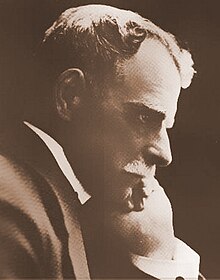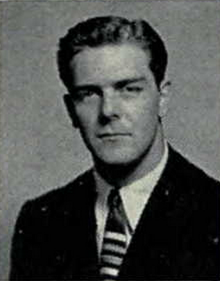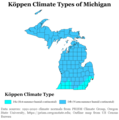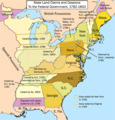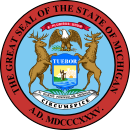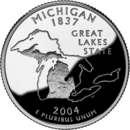Portal:Michigan
The Michigan Portal  Michigan (/ˈmɪʃɪɡən/ MISH-ig-ən) is a state in the Great Lakes region of the Upper Midwest region of the United States. It borders Wisconsin to the northwest in the Upper Peninsula, and Indiana and Ohio to the south in the Lower Peninsula; it is also connected by Lakes Superior, Michigan, Huron, and Erie to Minnesota and Illinois, and the Canadian province of Ontario. With a population of nearly 10.12 million and an area of 96,716 sq mi (250,490 km2), Michigan is the 10th-largest state by population, the 11th-largest by area, and the largest by area east of the Mississippi River. Its capital is Lansing, and its largest city is Detroit. Metro Detroit is among the nation's most populous and largest metropolitan economies. The name derives from a gallicized variant of the original Ojibwe word ᒥᓯᑲᒥ (mishigami), meaning "large water" or "large lake". Michigan consists of two peninsulas. The Lower Peninsula resembles the shape of a mitten, and comprises a majority of the state's land area. The Upper Peninsula (often called "the U.P.") is separated from the Lower Peninsula by the Straits of Mackinac, a five-mile (8 km) channel that joins Lake Huron to Lake Michigan. The Mackinac Bridge connects the peninsulas. Michigan has the longest freshwater coastline of any political subdivision in the United States, being bordered by four of the five Great Lakes and Lake St. Clair. It also has 64,980 inland lakes and ponds. Michigan has the second-most water area of any state, behind only Alaska. The area was first occupied by a succession of Native American tribes over thousands of years. In the 17th century, French explorers claimed it as part of the New France colony, when it was largely inhabited by Indigenous peoples. French and Canadian traders and settlers, Métis, and others migrated to the area, settling largely along the waterways. After France's defeat in the French and Indian War in 1762, the region came under British rule. Britain ceded the territory to the newly independent United States after its defeat in the American Revolutionary War. The area was part of the larger Northwest Territory until 1800, when western Michigan became part of the Indiana Territory. Michigan Territory was formed in 1805, but some of the northern border with Canada was not agreed upon until after the War of 1812. Michigan was admitted into the Union in 1837 as the 26th state, a free one. It soon became an important center of industry and trade in the Great Lakes region, attracting immigrants in the late 19th and early 20th centuries from many European countries. Immigrants from Finland, Macedonia, and the Netherlands were especially numerous. Migration from Appalachia and of Black Southerners as part of the Great Migration increased in the 1930s, with many settling in Metro Detroit. Although Michigan has developed a diverse economy, in the early 20th century it became widely known as the center of the U.S. automotive industry, which developed as a major national economic force. It is home to the country's three major automobile companies (whose headquarters are all in Metro Detroit). Once exploited for logging and mining, today the sparsely populated Upper Peninsula is important for tourism because of its abundance of natural resources. The Lower Peninsula is a center of manufacturing, forestry, agriculture, services, and high-tech industry. (Full article...) Entries here consist of Good and Featured articles, which meet a core set of high editorial standards.
Ann Arbor is a city in and the county seat of Washtenaw County, Michigan, United States. The 2020 census recorded its population to be 123,851, making it the fifth-most populous city in Michigan. It is the principal city of the Ann Arbor metropolitan area, which encompasses all of Washtenaw County and had 372,258 residents in 2020. Ann Arbor is also included in the Metro Detroit combined statistical area and the Great Lakes megalopolis. Ann Arbor is home to the University of Michigan. The university significantly shapes Ann Arbor's economy as it employs about 30,000 workers, including about 12,000 in its medical center. The city's economy is also centered on high technology, with several companies drawn to the area by the university's research and development infrastructure. (Full article...)Selected picture -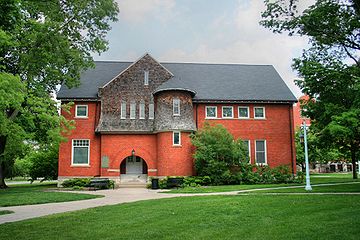 Eustace-Cole Hall (formerly Harry J. Eustace Hall, formerly Horticultural Laboratory) is a structure on the campus of Michigan State University. Eustace-Cole is the only building on MSU's main campus that is on the National Register of Historic Places. Did you know -
Related portalsSelected article -
Albert May Todd (June 3, 1850 – October 6, 1931), known as "The Peppermint King of Kalamazoo," was an American chemist, businessman, and politician from the state of Michigan. A philanthropist and advocate of public ownership of utilities, Todd made his fortune as the founder of the A.M. Todd Company, a world leader in the production of peppermint oil and other botanical extracts. Todd was also a renowned bibliophile, portions of whose collection now grace the holdings of several American universities. He served one term in the United States House of Representatives. (Full article...)
Selected biography -Richard Gale Rifenburg (August 21, 1926 – December 5, 1994) was an American football player and a pioneering television broadcaster for the forerunner to WIVB-TV in Buffalo. He played college football for the University of Michigan Wolverines in 1944 and from 1946 to 1948. He was a consensus selection at end on the 1948 College Football All-America Team. Rifenburg played professionally in the National Football League (NFL) with the Detroit Lions for one season in 1950. After retiring from football he settled in Buffalo and became a sports broadcaster. He worked as a color commentator and as a play-by-play announcer for the Buffalo Bulls. He hosted various television and radio sports shows and was eventually inducted into the Buffalo Broadcasters Hall of Fame. In college, he led the Big Ten Conference in single season receptions during his senior year and set Michigan Wolverines receptions records for both career touchdown and single-season touchdowns. He had also been a Michigan High School Athletic Association (MHSAA) state champion in both basketball and track and field. His college career was interrupted by World War II service, and his high school career was also affected by the war due to the MHSAA's cancellation of state championships in all sports in 1943. (Full article...)General imagesThe following are images from various Michigan-related articles on Wikipedia.
TopicsCategoriesSymbols
Lists
Related pagesWikimediaThe following Wikimedia Foundation sister projects provide more on this subject:
Things you can doDiscover Wikipedia using portals | ||||||||||||||||||||||||||||||||||||
- Pages using the Phonos extension
- Portals with triaged subpages from October 2019
- All portals with triaged subpages
- All portals
- Portals with no named maintainer
- Pages including recorded pronunciations
- Random portal component with more available subpages than specified max
- Random portal component with 21–25 available image subpages
- Michigan portals
- United States portals by state or territory
- WikiProject Michigan
- Michigan
- Portals needing placement of incoming links

